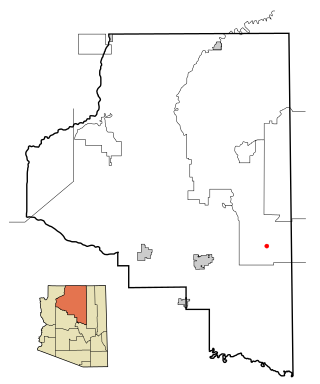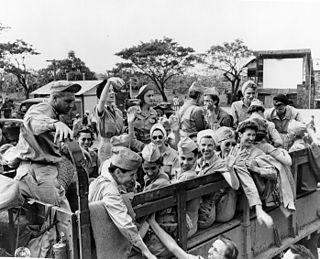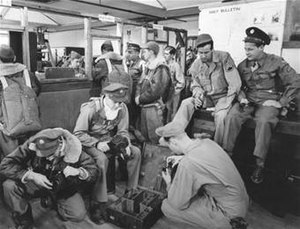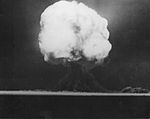
A code talker was a person employed by the military during wartime to use a little-known language as a means of secret communication. The term is most often used for United States service members during the World Wars who used their knowledge of Native American languages as a basis to transmit coded messages. In particular, there were approximately 400 to 500 Native Americans in the United States Marine Corps whose primary job was to transmit secret tactical messages. Code talkers transmitted messages over military telephone or radio communications nets using formally or informally developed codes built upon their Indigenous languages. The code talkers improved the speed of encryption and decryption of communications in front line operations during World War II and are credited with a number of decisive victories. Their code was never broken.

LeuppLOOP is a census-designated place (CDP) in Coconino County, Arizona, on the Navajo Nation, United States. The population was 951 at the 2010 census.

The Philippine Scouts (Filipino: Maghahanap ng Pilipinas/Hukbong Maghahanap ng Pilipinas) was a military organization of the United States Army from 1901 until after the end of World War II. These troops were generally Filipinos and Filipino-Americans assigned to the United States Army Philippine Department, under the command of American commissioned officers (though a handful of Filipino Americans received commissions from the United States Military Academy). Philippine Scout units were given the suffix "(PS)", to distinguish them from other U.S. Army units.
The 200th Coast Artillery (AA) (200 CA) was a United States Army unit during the first half of World War II. Today descendant elements serve with the New Mexico Army National Guard as the 200th Infantry.

The Bataan Death March was the forcible transfer by the Imperial Japanese Army of 75,000 American and Filipino prisoners of war (POW) from the municipalities of Bagac and Mariveles on the Bataan Peninsula to Camp O'Donnell via San Fernando.
Joe Kieyoomia was a Navajo soldier in New Mexico's 200th Coast Artillery unit who was captured by the Imperial Japanese Army after the fall of the Philippines in 1942 during World War II. Kieyoomia was a POW in Nagasaki at the time of the atomic bombing but survived, reportedly having been shielded from the effects of the bomb by the concrete walls of his cell.
Philip Johnston was an American civil engineer who is credited with proposing the idea of using the Navajo language as a Navajo code to be used in the Pacific Theater during World War II.

The New Mexico National Guard is the militia of the U.S. state of New Mexico. Comprising the New Mexico Army National Guard and the New Mexico Air National Guard, it is part of the National Guard of the United States, a reserve force under both state and federal jurisdiction.

As many as 25,000 Native Americans in World War II fought actively: 21,767 in the Army, 1,910 in the Navy, 874 in the Marines, 121 in the Coast Guard, and several hundred Native American women as nurses. These figures included over one-third of all able-bodied Native American men aged 18 to 50, and even included as high as seventy percent of the population of some tribes. The first Native American to be killed in WWII was Henry E. Nolatubby from Oklahoma. He was part of the Marine Detachment serving on the USS Arizona and went down with the ship on December 7, 1941. Unlike African Americans or Asian Americans, Native Americans did not serve in segregated units and served alongside white Americans.

The Angels of Bataan were the members of the United States Army Nurse Corps and the United States Navy Nurse Corps who were stationed in the Philippines at the outset of the Pacific War and served during the Battle of the Philippines (1941–1942). When Bataan and Corregidor fell, 11 navy nurses, 66 army nurses, and 1 nurse-anesthetist were captured and imprisoned in and around Manila. They continued to serve as a nursing unit while prisoners of war. After years of hardship, they were finally liberated in February 1945.
John Brown Jr. was an American Navajo Code Talker during World War II.

Bataan Military Academy was a tuition-free, co-ed, college-prep public day high school. All cadets were members of the Navy Junior Reserve Officers Corps, the U.S. Navy's youth organization. Bataan opened at the beginning of the 2007–2008 school year with freshmen and sophomores. The school closed at the end of the 2015–2016 school year due to declining enrolment.

Santo Tomas Internment Camp, also known as the Manila Internment Camp, was the largest of several camps in the Philippines in which the Japanese interned enemy civilians, mostly Americans, in World War II. The campus of the University of Santo Tomas in Manila was utilized for the camp, which housed more than 3,000 internees from January 1942 until February 1945. Conditions for the internees deteriorated during the war and by the time of the liberation of the camp by the U.S. Army many of the internees were near death from lack of food.

The Santa Fe riot was a confrontation at a Japanese internment camp near Santa Fe, New Mexico, during World War II. On March 12, 1945, approximately 275 internees assembled in Camp Santa Fe to watch and protest the removal of three men to another camp. During which, a scuffle broke out between the internees and the Border Patrol agents who were guarding the facility, resulting in the use of tear gas grenades, batons, and the serious injury of four internees.

The Lordsburg killings refers to the shooting of two elderly Japanese American men named Toshiro Kobata and Hirota Isomura at an internment camp outside Lordsburg, New Mexico, on July 27, 1942. The shooter, Private First Class Clarence Burleson, was charged with murder, which was later reduced to manslaughter, but he was later acquitted after testifying that he was following military protocol.

Chester Nez was an American veteran of World War II. He was the last surviving original Navajo code talker who served in the United States Marine Corps during the war.
The 515th Coast Artillery was a regiment of the United States Army first created in the early 1920s.

Alfred K. Newman was a United States Marine, best known for serving as a Navajo code talker during World War II.

Dr. Carl Nelson Gorman, also known as Kin-Ya-Onny-Beyeh (1907–1998) was a Navajo code talker, visual artist, painter, illustrator, and professor. He was faculty at the University of California, Davis, from 1950 until 1973. During World War II, Gorman served as a code talker with the United States Marine Corps in the Pacific.






























